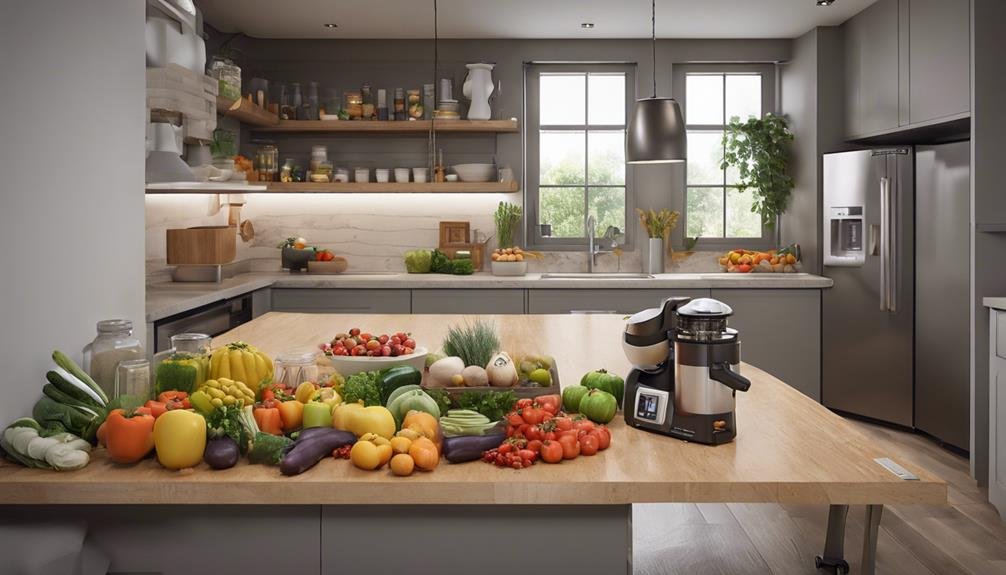Healthy Kitchens: Organizing Your Space for Better Eating Habits
When it comes to fostering healthier eating habits, the key lies in the organization of your kitchen space. By strategically arranging your kitchen to support your goals, you can create an environment that nudges you towards better choices effortlessly. From decluttering and efficient storage solutions to designated snack zones and meal prep stations, each element plays an essential role in shaping your dietary habits. So, how exactly can you transform your kitchen into a hub of wellness and mindful eating? Let’s explore the foundational steps to a healthier kitchen setup.
Key Takeaways
- Declutter for mindful eating habits and better food choices.
- Use space-saving containers and labels for efficient ingredient storage.
- Organize fridge for food rotation, shelf optimization, and contamination prevention.
- Designate snack zones with clear containers for healthier choices.
- Set up meal prep station with categorized ingredients for streamlined cooking.
Decluttering for a Healthier Environment
To create a healthier environment that promotes better eating habits, decluttering your space is essential. A clutter-free kitchen can have a significant impact on your food choices and eating behaviors. Research suggests that a chaotic environment can lead to mindless eating, whereas a tidy space can encourage mindful eating. By organizing your kitchen, you can cultivate healthy habits effortlessly.
When your kitchen is free of clutter, you’re more likely to make conscious choices about what you eat. A clean and organized space can reduce stress and promote a sense of calm, making it easier to focus on preparing and enjoying nutritious meals. This environment encourages mindful eating practices, such as paying attention to portion sizes and savoring each bite.
Efficient Storage Solutions for Ingredients
Maximizing the use of space in your kitchen can enhance efficiency when storing ingredients. When it comes to pantry organization, utilizing space-saving solutions like stackable containers, adjustable shelves, and door racks can help optimize your storage area.
For homeowners in Sacramento, upgrading to customized kitchen cabinets in Sacramento can enhance storage efficiency and overall kitchen aesthetics. These options allow you to maximize space while matching your kitchen’s style.
Clear containers are particularly useful as they allow you to see the contents easily, reducing the chances of forgetting about certain ingredients.
To further streamline your ingredient storage, consider labeling each container with the item’s name and expiration date. This practice not only aids in inventory management but also helps prevent food waste by ensuring you use ingredients before they expire.
Additionally, grouping similar items together in your pantry can make it easier to locate what you need while cooking.
Implementing these efficient storage solutions and organization techniques in your kitchen can save you time and effort, making meal preparation a more streamlined and enjoyable process.
Organizing Your Fridge for Success
Efficiently organizing your fridge can greatly impact your ability to maintain a healthy eating routine and reduce food waste. Start by practicing food rotation and shelf organization. Place newer items towards the back of the fridge and older items towards the front to make sure that older perishables are used before they spoil.
For shelf organization, designate specific areas for different food groups such as fruits, vegetables, dairy, and proteins. This helps you easily identify ingredients and prevents cross-contamination.
Temperature control is vital for food safety. Keep your fridge at or below 40°F (4°C) to slow the growth of bacteria and prevent foodborne illnesses. Use a refrigerator thermometer to confirm the temperature stays consistent. Store perishable items like raw meat, poultry, and seafood on the bottom shelf to prevent drips from contaminating other foods.
Additionally, utilize the door shelves for condiments and non-perishable items, as the temperature fluctuates more in this area. By implementing these strategies, you can maintain a well-organized fridge that promotes healthy eating habits and minimizes food waste.
Designating Snack Zones for Easy Access
When it comes to improving your eating habits, having designated snack zones for easy access can make a significant difference.
By organizing your space to have readily available, healthy snack options in accessible areas, you’re more likely to make better choices throughout the day.
Creating snack zones not only promotes healthier eating habits but also helps in reducing mindless snacking on less nutritious options.
Snack Location Accessibility
Create designated snack zones in your living space for easy access and convenience when hunger strikes. Setting up a designated snack station with healthy options can help you make better food choices throughout the day.
By designating specific areas for snacks, you can guarantee that nutritious options are readily available and easily accessible, promoting healthier eating habits.
When creating your snack station, consider placing it in a high-traffic area like the kitchen or living room. Stock this area with a variety of healthy options such as fresh fruits, vegetables, nuts, yogurt, and whole-grain crackers.
Organizing your snacks in clear containers or bowls can make them more appealing and increase the likelihood of reaching for these options when hunger strikes.
Having a designated snack zone with healthy choices at arm’s reach can prevent mindless snacking on less nutritious foods. By making it easier to grab a healthy snack, you’ll be more likely to fuel your body with nutrient-dense options throughout the day.
Organized Snack Storage
To optimize your snacking habits and maintain easy access to healthy options, establish designated snack zones within your living space. Utilize portable containers for storing snacks, ensuring they’re easily accessible and visible. These containers aid in portion control, helping you make mindful choices when reaching for a snack. Consider dividing snacks into categories such as fruits, nuts, and whole-grain crackers to create a well-rounded selection.
Implement a system for snack rotation to prevent items from expiring. Check expiration dates regularly and discard any expired snacks to maintain freshness and quality. By organizing your snacks in designated areas, you can easily see what options you have available and avoid reaching for less healthy alternatives out of convenience.
Creating a visually appealing snack storage area can also encourage healthier choices. Use transparent containers or open baskets to display your snacks, making them more enticing and increasing the likelihood of choosing nutritious options.
Setting Up a Meal Prep Station
Organize your kitchen with designated meal prep stations to streamline your cooking process and encourage healthier eating habits. Setting up a meal prep station can greatly improve meal prep efficiency and station organization. Begin by choosing a spacious and well-lit area in your kitchen that allows for easy movement and access to essential tools and ingredients. Consider optimizing your workspace by keeping frequently used items such as cutting boards, knives, measuring cups, and mixing bowls within arm’s reach. This setup will minimize the time spent searching for tools and reduce the likelihood of accidents during food preparation.
To further enhance station organization, categorize your ingredients based on the type of meal you’re preparing. For example, group together vegetables, proteins, grains, and spices to create a more systematic workflow. Additionally, invest in storage containers that are easily stackable and transparent for better visibility of ingredients.
Utilizing Labeling Systems for Better Visibility
When organizing your kitchen for better eating habits, consider utilizing labeling systems to enhance visibility. Clear label placement guarantees you can easily identify ingredients and meals.
Color-coded organization and using an easy-to-read font can further streamline your meal prep process.
Clear Label Placement
Guarantee the visibility and accessibility of items in your organized space by implementing a clear labeling system that promises quick and easy identification. Clear label placement offers numerous benefits, including improved organization, time-saving efficiency, and a visually appealing kitchen. Labels help you locate items effortlessly, reducing the chances of clutter or disorganization.
Common labeling mistakes include using illegible handwriting, inconsistent labeling styles, or failing to update labels as items are moved or replaced. These errors can lead to confusion and defeat the purpose of having a labeling system in place.
Make sure that labels are placed prominently, with clear fonts and colors that contrast with the background for easy reading.
Color-Coded Organization
For a more visually appealing and efficient organization system, consider implementing a color-coded labeling system in your space.
Color coded meal planning can revolutionize your kitchen organization by visually separating different food categories. Imagine easily spotting proteins, grains, and vegetables at a glance, streamlining your meal prep process. This method not only enhances the visual appeal of your pantry but also makes it easier to maintain an organized system for your pantry essentials.
By assigning specific colors to different food groups or meal categories, you can simplify the task of locating ingredients and planning your meals.
Kitchen color coordination can further elevate your space’s aesthetic while serving a practical purpose. Use color-coded labels on containers, shelves, or bins to make sure everything has its designated place. This approach not only adds a pop of color to your kitchen but also aids in quick identification and retrieval of items during meal preparation.
Embrace the power of color-coded organization to transform your kitchen into a well-structured and visually appealing space for efficient meal planning and preparation.
Easy-To-Read Font
Consider incorporating labels with easy-to-read fonts to enhance visibility and efficiency in your kitchen organization system. When selecting font styles for labeling your pantry, spice jars, or meal prep containers, opt for clear and legible fonts such as Arial, Verdana, or Calibri. These fonts are known for their readability, ensuring that your labels are easily understood at a glance.
In a busy kitchen environment, where quick access to ingredients is essential for meal planning, using fonts that are simple, bold, and appropriately sized can make a significant difference. Arrange your labels strategically based on your kitchen layout to create a more intuitive and organized space.
For instance, label shelves, drawers, or storage bins with fonts that stand out against the background color to facilitate quick identification of items.
Incorporating Functional Cooking Zones
Create distinct functional cooking zones in your kitchen to streamline meal preparation and optimize efficiency. Designate specific areas for different cooking techniques to create an ergonomic layout that enhances your cooking experience.
By organizing your kitchen into functional zones, you can improve your meal planning and make cooking a more enjoyable and efficient process.
Consider dividing your kitchen into zones such as a prep zone, cooking zone, baking zone, and cleaning zone. The prep zone should be equipped with cutting boards, knives, and other tools needed for food preparation.
The cooking zone, where your stove and pots/pans are located, should be easily accessible from the prep area. A designated baking zone with baking sheets, mixing bowls, and measuring tools will streamline baking tasks.
Lastly, the cleaning zone with the sink, dishwasher, and trash cans should be nearby for easy cleanup.
Enhancing Kitchen Lighting for Better Choices
To optimize your kitchen for healthier food choices, strategically place lighting fixtures to create a well-lit environment that fosters mindfulness and encourages nutritious meal decisions. Adjustable lighting allows you to customize the brightness level based on the time of day and your activities in the kitchen.
Consider incorporating mood lighting options to create a warm and inviting ambiance that makes cooking and eating more enjoyable.
Under cabinet lighting is essential for illuminating countertops and food preparation areas, reducing shadows and making it easier to see what you’re working with. This type of lighting can also enhance the overall aesthetic of your kitchen while providing functional benefits.
Additionally, overhead lighting fixtures can help brighten up the entire space, ensuring that every corner is well-lit and conducive to making healthy food choices.
Conclusion
Now that you’ve decluttered, organized, and optimized your kitchen for healthier eating habits, it’s time to reap the benefits of your efforts.
With a well-structured space, you can easily access nutritious ingredients, plan meals efficiently, and make better food choices.
Remember, a healthy kitchen isn’t just about what you eat, but how you set yourself up for success. So keep up the good work and enjoy the fruits of your labor!







